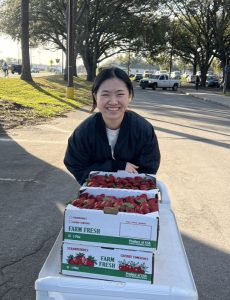 A warm welcome to Jingyi ‘Kini’ Cheng, the latest guest in our FSHN Research Journeys series, which follows graduate students’ research in the Food Science and Human Nutrition program at The University of Florida. Kini is a food science master’s degree student who is passionate about sharing the health-promoting benefits of fruits by extending their shelf-life and reducing food waste. Read about her research into developing a new method of lengthening strawberries’ shelf life while evaluating consumer acceptance of treated fruits.
A warm welcome to Jingyi ‘Kini’ Cheng, the latest guest in our FSHN Research Journeys series, which follows graduate students’ research in the Food Science and Human Nutrition program at The University of Florida. Kini is a food science master’s degree student who is passionate about sharing the health-promoting benefits of fruits by extending their shelf-life and reducing food waste. Read about her research into developing a new method of lengthening strawberries’ shelf life while evaluating consumer acceptance of treated fruits.
Kini:
As a Floridian, I am proud of our strawberry production and nationwide sales. But how frequently do I purchase strawberries from stores? The answer would be ‘rarely.’ I only make a purchase when I am confident that I will consume them within a maximum of five days. The blame lies with the short shelf-life of the strawberries. However, at the University of Florida, we have a game-changing project that aims to extend the shelf life of strawberries.
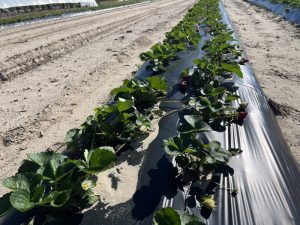
No more unnecessary strawberry waste
Florida grows 9,400 acres of strawberries annually, which are valued at $307.2 million.1 Strawberry fruits are perishable with a shelf-life of two weeks in cold storage and three to four days in room temperature storage.2 Due to their short shelf life, around 25% of strawberries are discarded at the distribution and retail level. This issue results in the loss of hundreds of millions of dollars every year.3
Strawberries’ perishability is due to heightened water activity (the amount of free water within the fruit), a significant sugar content, and thin fruit skins. Consequently, strawberries are more susceptible to various pests like the strawberry aphid as well as fungal growth such as gray mold (Botrytis cinerea).4–6
To avoid throwing out so many strawberries, developing new technologies designed to extend their shelf-life is crucial. With longer shelf-life, fewer strawberries would be discarded due to their perishable nature leading to increased profits for all stakeholders in the supply chain, including distribution centers and grocery stores.
My graduate research project is under the umbrella of a major proposal titled “Extending the Shelf Life of Florida Strawberries by Designing and Implementing New Post-harvest Technologies” by Dr. Liwei Gu and Dr. Yavuz Yagiz. There are four major tasks in the proposal:
- Extend and maximize the shelf life of Florida strawberries (gas treatment/fumigation).
- Extend strawberry shelf life and reduce pesticide residue simultaneously.
- Pilot testing of the new fumigation and dipping technologies.
- Disseminate research findings and assist with commercial implementation.
In my research project, I will focus on the first task: developing and examining the cotreatment of ethyl formate and carbon dioxide to extend strawberry shelf-life.
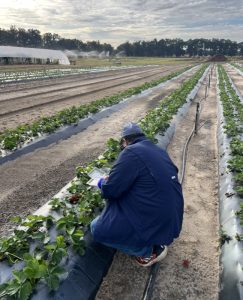
Kini’s research focus shifts toward real-world problems
Although my previous academic background concerned the effects of bioactive compounds in food on human health, I wanted to shift my focus closer to real-world problems. Fortunately, my major advisor, Dr. Liwei Gu, has great expertise in phytochemicals. Phytochemicals, derived from edible plants, play a crucial role in combating oxidative stress and reducing the risk of diseases like cancer and cardiovascular issues.
I was initially drawn to his research focus because Dr. Gu and I share a common belief in the immense potential of food as ‘nature’s medicine’. Many fruits are known to have health-promoting effects due to the presence of various bioactive compounds. People may not be familiar with the complicated names of those compounds, but they are all familiar with the names of fruits.
For example, everyone knows strawberries, but how many people will be familiar with anthocyanins with potential visual and neurological benefits?7, 8 I am interested in making my research accessible to everyone. Our goal is to develop and implement new technology that will help extend the shelf-life of strawberries, thereby reducing unnecessary waste.
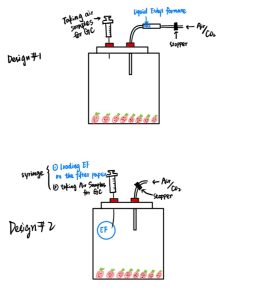
Studying the Fumigation Method and Evaluating Consumers’ Acceptance
To extend the shelf-life of strawberries, our team will treat the fruits through fumigation (sealed and air-tight treatment). Based on current research, we expect fumigation with ethyl formate (EF) and carbon dioxide (CO2) to extend strawberries’ shelf life by limiting fungus growth and pests.
We chose EF as one of the treatments because the U.S. Food and Drug Administration (FDA) designates it as generally recognized as safe (GRAS), and studies have shown EF’s potential in antifungal and anti-pest effects on various fruits, like citrus, table grapes, and apples.9–11 Evidence suggests that the combination of EF and CO2 could increase the mortality of pests, yet there exists no research on how shelf life is affected. Therefore, our project will focus on strawberry quality and shelf-life after treatment with EF and CO2.12
Moreover, we are also interested in examining the consumer acceptance of the treated strawberries. For example, a higher concentration of EF may lead to color changes or smell and taste differences between treated and untreated berries. After ensuring EF residue concentration in the treated strawberries is less than 0.01% (by FDA standards)13, we will recruit volunteers to conduct triangle tests.
In these tests, known as triangle tests, three strawberry sample groups with randomly assigned three-number-codes will be given. Two samples will be the same (both treated or untreated) and the other one will be different.14 Then volunteers will be asked to determine which one is different from the others. With that, we would be able to conclude if there is any detectable difference between the treated and untreated strawberries.
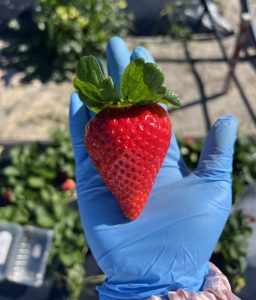
Staying optimistic and focusing on the future despite challenges
The first challenge in this project would be to design a method to evaporate EF. Fortunately, we will be able to cooperate with the UF Horticultural Science Department which has expertise in post-harvest science. With their help, we will have a more skilled approach to achieving our research goals.
Another challenge would be the timing of the strawberry harvest. We plant our strawberries at Citra (Plant Science Research and Education Unit), meaning we will have much more controlled subjects for further experiments. However, harvesting is very time-sensitive, and we will only be able to harvest during winter and early spring. We must ensure a steady workflow and proficient techniques during that short period. To address this problem, we plan to conduct preliminary trials with purchased strawberries to determine optimal gas concentrations.
Also, there exists a possibility that the treatments will not significantly improve shelf-life. To address this challenge, we would continue to examine higher concentrations of the gas treatment to maximize the extending effects. We could also examine other factors that could contribute to the decay of strawberries, including humidity, temperature, and pH.
If we observe antifungal effects, we can conduct inoculation and plating to test them. Moreover, we prepared a second approach with the cotreatment of sodium hydrosulfide hydrate (NaSH) and sodium nitroprusside (SNP). Though this approach uses liquid instead of gas, the overall methodology to determine the effects on strawberries’ shelf-life will be similar. Additionally, researchers show this combination can extend shelf life.15
Overall, the project is challenging yet promising. Our team is confident we will accomplish our goals, resulting in consumers being able to enjoy their strawberries without worrying about waste.

Jingyi (Kini) Cheng is a first-year food science master’s student in the UF/IFAS FSHN department. She graduated with a dual degree in food science and nutrition science at the University of Massachusetts-Amherst and conducted research with Dr. Yeonhwa Park focusing on the anti-obesity effects of plant-derived bioactive compound Baicalein. Kini firmly advocates for the transformative potential of food and dietary choices to prevent and even treat chronic diseases. She is passionate about developing methods to provide healthier, more delicious, and safer food products in the future that would give everyone smiles.
References
- Graf R. Farm Facts: Strawberries. Florida Farm & Family. Published November 30, 2020. Accessed September 24, 2023. https://floridafarmfamily.com/farm/crops-livestock/farm-facts-strawberries/
- Gol NB, Patel PR, Rao TVR. Improvement of quality and shelf-life of strawberries with edible coatings enriched with chitosan. Postharvest Biology and Technology. 2013;85:185-195. doi:10.1016/j.postharvbio.2013.06.008
- 24 Million Pounds Of Strawberries Each Week Might Get Thrown In The Trash. LAist. Published April 16, 2020. Accessed October 12, 2023. https://laist.com/news/food/food-waste-strawberries-donation-coronavirus
- Strawberry Diseases | University of Maryland Extension. Accessed November 8, 2023. https://extension.umd.edu/resource/strawberry-diseases
- Botrytis Fruit Rot / Gray Mold on Strawberry | NC State Extension Publications. Accessed November 8, 2023. https://content.ces.ncsu.edu/botrytis-cinerea-botrytis-fruit-rot-and-blight-on-strawberry
- Feliziani E, Romanazzi G. Postharvest decay of strawberry fruit: Etiology, epidemiology, and disease management. Journal of Berry Research. 2016;6(1):47-63. doi:10.3233/JBR-150113
- Taghavi T, Patel H, Akande OE, Galam DCA. Total Anthocyanin Content of Strawberry and the Profile Changes by Extraction Methods and Sample Processing. Foods. 2022;11(8):1072. doi:10.3390/foods11081072
- Khoo HE, Azlan A, Tang ST, Lim SM. Anthocyanidins and anthocyanins: colored pigments as food, pharmaceutical ingredients, and the potential health benefits. Food Nutr Res. 2017;61(1):1361779. doi:10.1080/16546628.2017.1361779
- Agarwal M, Ren Y, Newman J, Learmonth S. Ethyl Formate: A Potential Disinfestation Treatment for Eucalyptus Weevil ( Gonipterus platensis ) (Coleoptera: Curculionidae) in Apples. J Econ Entomol. 2015;108(6):2566-2571. doi:10.1093/jee/tov242
- Park MG, Lee BH, Yang JO, et al. Ethyl Formate as a Methyl Bromide Alternative for Fumigation of Citrus: Efficacy, Fruit Quality, and Workplace Safety. Neven LG, ed. Journal of Economic Entomology. 2021;114(6):2290-2296. doi:10.1093/jee/toab175
- Simpson T, Bikoba V, Tipping C, Mitcham EJ. Ethyl Formate As a Postharvest Fumigant for Selected Pests of Table Grapes. JOURNAL OF ECONOMIC ENTOMOLOGY. 2007;100(4).
- Simpson T, Bikoba V, Mitcham EJ. Effects of ethyl formate on fruit quality and target pest mortality for harvested strawberries. Postharvest Biology and Technology. 2004;34(3):313-319. doi:10.1016/j.postharvbio.2004.05.015
- CFR – Code of Federal Regulations Title 21. Accessed October 21, 2023. https://www.accessdata.fda.gov/scripts/cdrh/cfdocs/cfcfr/CFRSearch.cfm?fr=184.1295
- Sinkinson C. Chapter 7 – Triangle Test. In: Rogers L, ed. Discrimination Testing in Sensory Science. Woodhead Publishing Series in Food Science, Technology and Nutrition. Woodhead Publishing; 2017:153-170. doi:10.1016/B978-0-08-101009-9.00007-1
- Chang, Z.; Jingying, S.; Liqin, Z.; Changle, L.; Qingguo, W. Cooperative Effects of Hydrogen Sulfide and Nitric Oxide on Delaying Softening and Decay of Strawberry. International Journal of Agricultural and Biological Engineering 2014, 7 (6), 114–122. https://doi.org/10.25165/ijabe.v7i6.1582.
Looking for more posts exploring graduate research projects in the FSHN Department at the University of Florida?
Dive into the Research Journeys of other graduate students below.
M.S. Food Science
M.S. Nutritional Sciences
Ph.D. Food Science
Ph.D. Nutritional Sciences
Note: All images and contents are the property of UF/IFAS.



